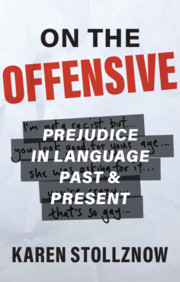1 - I’m Not a Racist, But …
Published online by Cambridge University Press: 06 October 2020
Summary
This chapter investigates historical and modern case studies, and media and popular culture examples of discriminatory language related to race, ethnicity, and national origin. Following a discussion of overt racism (especially slavery, segregation, and the treatment of Native people in the United States), we discuss several case studies that reveal hidden racism against various groups of people. For example, we will look at the 1992 Presidential campaign when candidate Ross Perot referred to his audience of African Americans as “You People” in a speech, and the racial controversy surrounding celebrity chef Paula Deen’s use of racial slurs. We talk about the problems with the slogan All lives matter, the saying playing the race card, and why people found Donald Trump’s Twitter comment, “I love Hispanics!” to be offensive. This chapter also examines linguistic discrimination, otherwise known as linguicism. We look at expressions of xenophobia, nationalism, and prejudice against immigrants and minorities on the basis of the language they speak or their accent. We look at cases in the media, within the education system, and the workplace. For example, we discuss Mock Spanish, Engrish, anti-Muslim prejudice, and we look at cases where people have been ordered to Speak English or get out of America!
- Type
- Chapter
- Information
- On the OffensivePrejudice in Language Past and Present, pp. 11 - 54Publisher: Cambridge University PressPrint publication year: 2020
- 1
- Cited by

